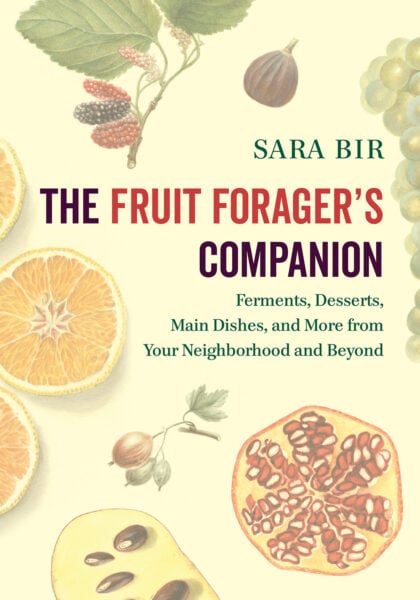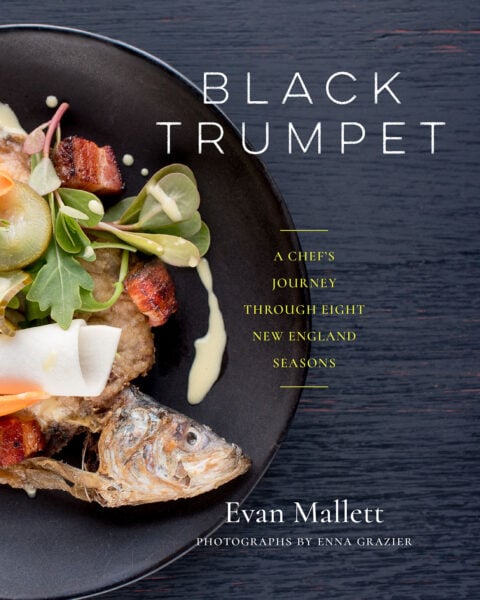Show-Stealing Desserts for Holiday Celebrations
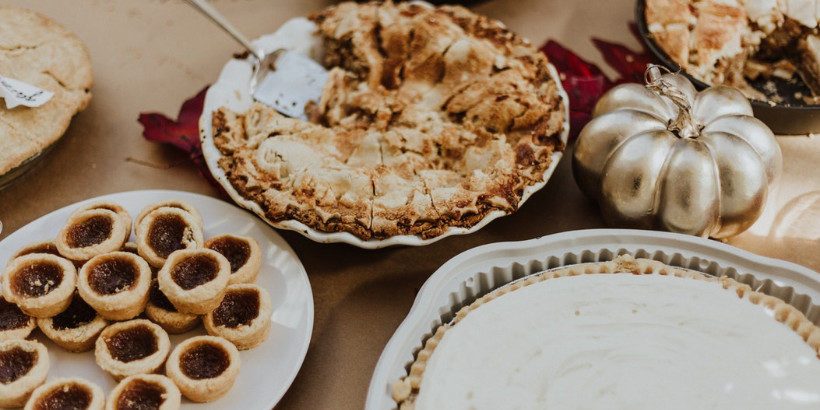
Holiday dinner dishes and sides get all the attention — but the reality is, dessert is where it’s at. Here are some show-stealing desserts to serve at your next holiday celebration.
The following recipes have been adapted for the web.
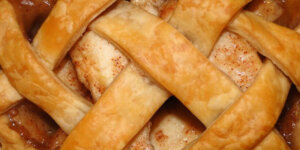 Lost Nation Cider Pie
Lost Nation Cider Pie
From The Apple Grower
Make ahead: The recipe calls for making cider jelly, which is done by boiling fresh apple cider to the jellying stage. The jelly may be made up to 5 days in advance, then covered and refrigerated. Alternatively, prepared cider jelly may be used.
Makes one 9-inch pie (8 servings)
Cider Jelly Ingredients
- 1/2 gallon fresh apple cider (see headnote; may substitute 1 cup store-bought cider jelly)
Filling Ingredients
- Homemade or store-bought pastry for a two-crust 9-inch pie
- 2 medium apples, such as Honeycrisp or Granny Smith, peeled, cored, cut in half, then cut into very thin slices
- 3/4 cup sugar
- 3 tablespoons cornstarch
- Pinch salt
- 1/2 cup boiling water
- 1 egg, lightly beaten
- 1 tablespoon unsalted butter, melted and cooled slightly
Cider Jelly Procedure
- Pour the cider into a medium heavy, nonreactive pot.
- Bring to a boil over high heat. Use a candy thermometer to measure the temperature, which should come up to 220 degrees (the jellying stage).
- Boil until the cider has reduced to almost 1 cup, adjusting the heat and stirring as needed to avoid scorching. This can take from 75 to 90 minutes.
- When the cider has reduced and thickened, remove it from the heat. Transfer to a heatproof container and cool to room temperature, then cover and refrigerate until ready to use.
Pie Procedure
- Preheat the oven to 425 degrees.
- Use the homemade or store-bought crust to line a 9-inch pie plate, folding under and pinching the edges to form a tidy rim.
- Arrange the apple slices on the surface of the bottom pie crust dough in flat layers. Have the top round of pie dough ready.
- Combine the sugar, cornstarch and salt in a medium mixing bowl. Add the cider jelly and just-boiled water; mix well.
- Whisk together the egg and melted butter in a liquid measuring cup, then add the mixture to the sugar-cider jelly mixture, stirring to combine. Pour the mixture carefully over the apples in the pie plate.
- Place the top crust on the pie; crimp the edges around the rim and use a knife to make several small cuts in the top (to allow steam to escape).
- Place the pie on a rimmed baking sheet (to catch any drips); bake for 40 minutes or until the top crust is golden.
- Transfer the pie to a wire rack to cool for at least 20 minutes before serving.
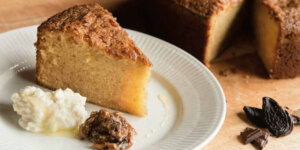 Olive Oil Cake with Prune Jam and Whipped Ricotta
Olive Oil Cake with Prune Jam and Whipped Ricotta
From Black Trumpet
Makes one 8-inch (20 cm) cake; Serves 12
This simple cake, created by Lauren Crosby, is one of my favorites from the Black Trumpet archives. And it is by far the best olive oil cake I have tried. I like to tell our guests that the use of olive oil in place of animal fat somehow makes this recipe healthier (ha!).
I also love that this dessert can be enjoyed at any time of day, especially for breakfast, and always in the company of a shot of good espresso.
Cake Ingredients
- ½ cup (120 ml) freshly squeezed orange juice (from 3 or 4 oranges)
- 2½ cups (570 g) sugar, divided
- 2 cups (240 g) flour
- ½ teaspoon baking powder
- ½ teaspoon baking soda
- 3 eggs (150 g liquid egg)
- 1¼ cups (295 ml) whole milk
- ¼ cup (60 ml) brandy
- 1½ cups (355 ml) olive oil
- Zest of 1 lemon
- 2 teaspoons ground anise seed
- 1 teaspoon salt
Jam Ingredients
- 8 prunes
- 4 dates, pitted
- ½ cup (115 g) sugar
- ¼ cup (60 ml) red wine
- 2 tablespoons apple brandy
- 2 tablespoons honey
- Zest of ¼ orange
Ricotta Ingredients
- 2 cups (455 g) whole-milk ricotta
- 1 cup (115 g) powdered sugar
- 1 teaspoon vanilla extract
Cake Procedure
- Preheat the oven to 325°F (165°C).
- Spray the bottom and sides of an 8-inch (20 cm) springform pan.
- Combine the orange juice and ½ cup (115 g) of the sugar in a small pan over medium heat and simmer until the sugar dissolves. Remove from the heat and set aside to cool.
- Sift the flour, baking powder, and baking soda into a medium bowl and set aside.
- Whip the eggs in a stand mixer (using the whisk attachment) on medium speed for 1 minute. Slowly add the remaining 2 cups (455 g) sugar and whip on medium speed until dissolved, about 3 minutes.
- Pour ¼ cup (60 ml) of the cooled orange syrup, along with the milk, brandy, and olive oil, into the egg-and-sugar mixture; whip on low speed until incorporated.
- Add the zest, anise seed, and salt, and mix just until combined.
- Using a spatula, fold the dry ingredients into the batter, mixing just until combined.
- Pour the batter into the prepared springform pan and bake on the middle shelf for about 1¼ hours, until the cake is dark golden brown, it’s set in the middle, and a cake tester inserted in the middle comes out clean.
- Let the cake cool to room temperature and brush with the remaining orange syrup before slicing into twelve pieces. Serve with Prune Jam and Whipped Ricotta (both recipes follow).
To serve the cake: Place a slice of cake on a dessert plate. Dollop some Whipped Ricotta on top, sprinkle with chocolate shavings, and serve with a spoonful of Prune Jam. Repeat with the remaining slices.
Jam Procedure
Makes 12 portions
We tested this recipe with plums dehydrated in-house, but you can use any prune or dried black plum
- Combine all the ingredients in a small, heavy-bottomed pan.
- Bring to a boil over medium-high heat, reduce the heat to low, and simmer 3 minutes.
- Remove from the heat and let the mixture cool in the pan.
- Transfer to the bowl of a food processor and pulse several times, stopping often to scrape down the bottom and sides.
- Continue pulsing until the ingredients are fully incorporated and smooth.
Ricotta Procedure
Makes a little more than 1 pint (475 ml)
- Whip the cheese on low speed in the bowl of a stand mixer fitted with the paddle attachment, about 2 minutes.
- Add the sugar and vanilla and continue whipping until combined.
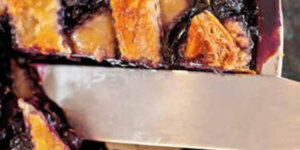 The Best Blackberry Pie in the World
The Best Blackberry Pie in the World
From Fruit Forager’s Companion
Serves 8–12
My mother clipped this recipe from the Columbus Dispatch “Reader’s Exchange” column decades ago, and to me it is the ne plus ultra of berry pies. I’ve made it with frozen berries, foraged berries, U-pick berries—you name it.
I love how the subtle spices give it a wine-y flavor, and the lemon zest perks up the dark juiciness of the berries. For this deep and dense pie to set correctly, the filling must come to a rapidly gurgling bubble. When in doubt, err on the side of baking longer.
Ingredients
- 1 or 2 unbaked Rye Pastry crusts, or your favorite piecrust recipe
- 5 cups (725 g) blackberries, thawed if frozen
- ⅔–1 cup (130–200 g) granulated sugar
- ¼ cup (35 g) unbleached all-purpose flour, plus more for rolling
- ½ teaspoon cinnamon
- ¼ teaspoon nutmeg
- Finely grated zest of 1 lemon
- Pinch salt
- 1 egg yolk
- 1 tablespoon heavy cream
- Turbinado or granulated sugar, for sprinkling
Procedure
- Preheat the oven to 425°F (220°C). Position racks in the upper and lower thirds of the oven.
- Roll out the bottom crust on a floured surface, and lay it in a greased 9-inch (23 cm) deep-dish pie plate. If you’re going to make a double-crusted pie, trim the excess crust so it overhangs about an inch (2.5 cm), but don’t pleat it.
- Roll out the top crust, if using, and slide it onto a cookie sheet.
- Refrigerate both crusts while you prepare the filling.
- Taste a few of the berries, and decide how much sugar you’d like to use. If the berries are quite tart, go for the full cup of sugar; if not, add as little as ⅔ cup.
- Put it in the bowl with the flour, spices, zest, and salt, and stir to combine so there are no lumps of flour. Fold in the berries. Scrape the filling into the lined plate. Top with the top crust or build a lattice crust on top, and crimp or pleat the edges to seal.
- Combine the egg yolk and cream in a small bowl, and brush carefully over the top crust.
- Sprinkle with enough turbinado or granulated sugar so the crust sparkles.
- Set the pie on a foil-lined rimmed pizza pan or baking sheet to catch any filling that bubbles over.
- Set on the bottom rack, and bake 30 minutes. Move to the upper rack, reduce the temperature to 375°F (190°C), and bake 30 to 50 minutes more, until the filling is bubbling vigorously and the crust is prettily browned. (You may need to loosely tent the pie midway through baking to keep the top crust from getting too dark.)
- Set the pie on a rack to cool. If you cut into the pie while it is still warm, the filling will be a wonderful gushy mess. It’s easier to slice neatly the next day, when you should eat it for breakfast. Serving vanilla ice cream on top is mandatory.
Also try with: Raspberries, black raspberries, or mulberries. Also, you can substitute up to 2 cups of blueberries for some of the blackberries.
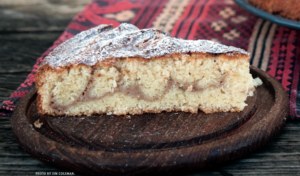 Medlar Cream Cake
Medlar Cream Cake
From The Occidental Arts and Ecology Center Cookbook
Makes one 12-inch round cake; Serves 16
This cake is so simple and yet so good—crunchy crust forms while the medlar pastry cream filling bakes into the center of the cake. Don’t worry if you have never seen or heard of a medlar!
They are extremely rare and never sold at markets, but you might just have a neighbor that grows this long-forgotten fruit. You can make this cake without the medlar and it’ll still have your guests oohing and aahing.
Medlar Pastry Cream Ingredients
- 13⁄4 cups whole milk
- 1⁄3 cup sugar, divided
- 3 large egg yolks
- 2 tablespoons plus 2 teaspoons cornstarch
- 2 tablespoons butter
- 3⁄4 cup medlar fruit, de-seeded through a sieve, or substitute dark apple or pear butter
Cake Ingredients
- 2 cups (4 sticks) unsalted butter, softened at room temperature
- 2 cups sugar
- 4 large eggs, room temperature
- 2 teaspoons vanilla extract
- 2 1⁄4 cups all-purpose flour
- 2 teaspoons baking powder
- 1 teaspoon salt
- 1 cup medlar pastry cream or regular pastry cream
Medlar Pastry Cream Procedure
Gather about a quart of bletted fruit. Medlar fruit is ripe when completely soft and squishy. We let the medlar blet or ripen on the tree, but you can harvest while firm and ripen in a cool room or fridge. The consistency is like pudding with a cluster of seeds. To get just the flesh with no seeds, push all the interior contents through a medium-sized sieve until you have 3⁄4 cup.
- Place the milk in a heavy-bottomed saucepan with half of the sugar. Heat on medium just until it starts steaming.
- While the milk is heating, whisk the egg yolks in a metal bowl with the other half of the sugar and the cornstarch.
- When the milk is hot, remove from the heat and whisk a little at a time into the yolk mixture, until you have added all the milk. Pour back into the saucepan.
- Turn the heat back to low and stir constantly with a spatula. Watch for the pastry cream to thicken to the point that your stirring spatula will leave an opening to the bottom of the pot and the mixture is thick like a pudding—this will happen fast! Remove from the heat immediately.
- Stir in the butter until smooth.
- If you are using the medlar fruit, then add this now by folding into the pastry cream.
- Set aside in the refrigerator. This can be made up to 2 days in advance, stored in the fridge.
Cake Procedure
Before beginning, it is very important to be sure that all your ingredients are soft and warm. Ideally, even the temperature in your kitchen should be warm to ensure a soft batter! Prepare a 12-inch cake pan with a parchment circle for the bottom and a thin layer of butter for the sides.
- Preheat the oven to 350°F.
- Cream the soft butter with the sugar in a stand mixer with a paddle attachment for a few minutes until the mixture is free of lumps and soft and creamy.
- Add the eggs, one at a time, scraping the bowl down after all the eggs have been added.
- Add the vanilla extract and mix to incorporate.
- Sift the flour, baking powder, and salt together into a separate bowl with a sieve. Gradually add the flour mixture to the butter-egg mixture without overmixing.
- Spoon the cake batter into a large tipless pastry bag.
- Pipe half of the batter in a tight spiral into the bottom of the pan. Pipe an extra ring around the inside edge of the pan, building up the sides slightly to create a well in the center that will prevent the filling from seeping out to the edge.
- Spread the medlar pastry cream evenly in this well using a small spatula or knife.
- Pipe the remaining cake batter in a spiral on top, sandwiching the pastry cream in the center.
- Use your spatula to move the cake batter over the top, covering the filling as much as possible. It’s okay if a bit of the filling shows through; when it heats in the oven it will spread out more.
- Bake for 1 to 11⁄2 hours. Check the cake at 1 hour; if it needs more time, let it continue baking for up to another half hour. It should spring back lightly in the center when it is done.
- Remove from the oven and let cool for 15 minutes before unmolding.
- Dust the top with powdered sugar, then slice and enjoy.
Recommended Reads
Seasonal Desserts: Apple Spice Bundt Cake & Pumpkin Pie with Hazelnut Crust
Recent Articles
Garlic mustard: while known as “invasive,” this plant can be consumed in its entirety and has great nutritional value. Plus, the garlic-flavor is a perfect addition to any recipe that calls for mustard! The following are excerpts from Beyond the War on Invasive Species by Tao Orion and The Wild Wisdom of Weeds by Katrina…
Read MoreOh, honeysuckle…how we love thee. If only there was a way to capture the sweet essence of this plant so we could enjoy it more than just in passing. Luckily, foraging and some preparation can help make that happen! Here’s a springtime recipe that tastes exactly like honeysuckle smells. The following excerpt is from Forage,…
Read MoreIntroducing…your new favorite brunch dish! This whole broccoli frittata is packed with fresh, wildcrafted flavors that are bound to help you start your day off on the right foot. The following is an excerpt from The Forager Chef’s Book of Flora by Alan Bergo. It has been adapted for the web. RECIPE: Whole Broccoli Frittata…
Read MoreWondering where to forage for greens this spring? Look no further than hedges, which serve as natural havens for wild greens and herbs! The following is an excerpt from Hedgelands by Christopher Hart. It has been adapted for the web. Food from Hedges: Salads and Greens Let’s start by looking at all the wild foods…
Read MoreThere’s a whole new world out there when it comes to koji. It doesn’t matter if you’re making bread, cheese, or ice cream, koji helps you pump up the flavor! Growing Koji in Your Own Kitchen Koji, the microbe behind the delicious, umami flavors of soy sauce, miso, fermented bean sauce, and so many of…
Read More

